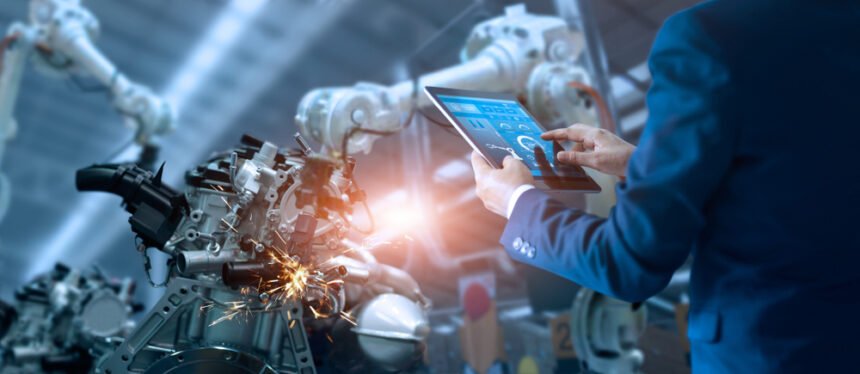A number of manufacturers have started using artificial intelligence more than ever. They have found that AI is a vital component of their operations, so it cannot be overlooked. ResearchandMarkets.com projects that the market for AI in manufacturing will be worth $16.7 billion by 2026.
One of the many awesome things about AI is that it can help streamline the manufacturing process. AI technology can also help companies make sure that quality assurance standards are met more consistently and safety standards are enhanced.
We previously talked about the role of augmented reality in manufacturing, but there are other AI developments that have been at least as beneficial. One of the many new AI technologies that is being integrated into the manufacturing sector is robotic polishing. This technology is mostly used to fine-tune the product and make sure that the final touches are done to perfection.
Robotic Polishing is an Example of AI Manufacturing Technology in Action
Polishing is for many products the last step in the manufacturing process. Every product needs to be properly finished to appeal to customers. Before a product is polished, it is often not ready for the market. This is an important yet often overlooked benefit of using AI in the manufacturing process.
Many manufacturers in different sectors of production need to polish their products. Robotic polishing is an AI-driven alternative to traditional polishing using an abrasive polishing machine. Companies with this machine don?t have to throw it away as the robot can work together with it for a better finish.
Players in the following industries can adopt the use of robots for robotic polishing of their products.
Automotive
The automotive industry is one of the leading manufacturing industries in the world. Different companies in the industry produce cars while others produce different parts of automobiles.
Intellias reports that the automotive industry is highly reliant on new AI developments, which includes robotic polishing. All these automobile parts need to be polished for the final product to be as alluring as they appear in the showrooms.
Being among the oldest industries in the world, manufacturers of parts and automobiles have been polishing their cars and parts with polishing machines.
Recently, as the automobile industry has adopted robots for their production processes, robotic polishing has gained lots of prominence. Robots can easily collaborate with traditional polishing machines to produce a beautiful end product.
Painted surfaces and parts of vehicles can be polished with robotic polishing to make sure that they have smooth surfaces. Engine parts and other components can also be polished with robot polishing.
Aerospace
The aerospace industry is also another industry that can and has increasingly adopted robot polishing as part of its AI strategy.
With robot polishing, manufacturers in the industry can polish plastic parts and components used to manufacture airplanes. To work properly, airplanes need to be smoothly streamlined to move up against the air pressure.
Human workers can’t polish the components and parts required to build the airplane. Robotic polishing is an integral part of the aerospace industry that ensures that products from the industry are properly built. Machine learning helps them perform these tasks much more easily.
Furniture and Interior Design
For most industries, polishing products is for both aesthetic and functional purposes. One of the industries that need aesthetic polishing is the furniture and interior design industry.
When furniture products are made, they need to be polished for them to look good and appeal to their target customers. As furniture companies grow, most of their work remains manual.
For the furniture and interior design industry, robotic polishing is an integral process. This is because, to make a product, you will need to polish every part of the product individually. Left to individual workers, polishing will take lots of time before production starts.
The only way to save time and polish the furniture smoothly is to introduce robotic polishing. Robotic polishing uses robots to polish and sand furniture products. The robots have force control capabilities that ensure that the robot doesn?t break the furniture during polishing.
Robot polishing and sanding in the furniture and interior industry makes sure that the products made are aesthetically appealing to potential customers.
Steel Products Manufacturing
The steel industry has been around for ages. Steel products are used in multiple industries. Steel products need to be polished and sanded for aesthetic value and their correct functionality. Before steel products are polished, they are rough. They can?t be used in this condition.
Thus, polishing and finishing is an integral aspect of the steel industry. Since the industry has existed for a long time, they have polishing machines. The introduction of robotic polishing in the industry will combine robots and polishing machines.
Robots can hold the steel rod and load it onto the polishing machine thus enabling collaboration.
Robotic Polishing is a Prime Example of the Wonders of AI in Manufacturing
There are a number of new developments in AI technology in the manufacturing sector. Robotic polishing is one of them. Robotic polishing is integral for all industries seeking to automate their production processes with robotics. Its useful for aesthetic purposes making components and final products stand out in the market. Polishing is also functional. Polished products are sanitary and easy to use at home and in the factory.







